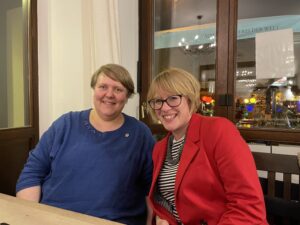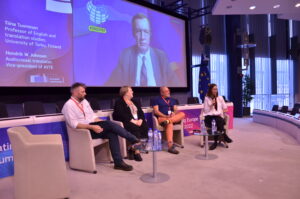Written by Hannah Silvester and Tiina Tuominen
Languages and the Media, Berlin
Hannah
Tiina and I recently attended Languages and the Media in Berlin to share news of SubComm and look for more people to join the community. It was great to be back in a room with all the wonderful people working on AVT, from Academics to LSP representatives, to translators themselves. We had encouraging conversations with people from all sectors and came away with plenty of ideas for the future. We had some exciting talks with practitioners about how we might work together in the future, and the kinds of barriers that might be present in academia – practitioner collaboration. We were also able to speak with some researchers who were keen to find out more about SubComm and how they can be involved. We want to grow the SubComm network as widely as possible, so we were happy to see this interest in our work and share our details. Hopefully, these contacts will be interested in writing guest posts for the blog, as well as joining our regular networking sessions.
As well as being able to talk to others who were interested in building a long-term reciprocal community of practice around subtitling, we realised that there is a lot that a community like SubComm could do to support subtitlers in overcoming some of the challenges they are facing in their work. The AVTE panel on Working Conditions in particular was eye-opening as regards issues around the so-called ‘talent crunch’ and falling rates. At the beginning of the panel, Kristijan Nicolic presented the findings of AVTE’s questionnaire on working conditions. The findings will be published soon, but during the lively and engaging discussion he chaired afterwards, some key issues emerged. The panel included Ekaterina Pliassova (NAViO), Tina Shortland (AVTE), Iris C. Permuy (ATRAE) and Per Nauclér (Plint). There was lots of discussion of rates, and around the question of whether audiovisual translators feel able to negotiate, or indeed can afford the potential risk of losing clients. Participants also talked about the best way to determine rates – whether it should be per subtitle, per programme minute, or per hour – and some LSP representatives seemed interested in the practitioners’ thoughts on this. The issue of the ‘talent crunch’ came up again, and Iris asked whether there is a talent crunch, or a refusal of experienced audiovisual translators to accept certain working conditions. She went on to note that if there was actually a ‘talent crunch’, then rates should be going up and up. Subtitler working conditions is an area in which we feel the SubComm community could work together to raise awareness and share resources in the fight to ensure the sustainability of the profession, for current subtitlers, and the future subtitlers that are currently being trained.

Translating Europe Forum, Brussels
Tiina
After Languages & the Media, I travelled to Brussels, to the annual Translating Europe Forum. I had been invited to take part in the panel “University curricula – are they attractive and complete enough?” The theme of the entire forum was “Access for All: Going beyond translating text”, so a lot of the conversations were closely related to audiovisual translation and accessibility, and the programme included many speakers from AVTE, as well as other audiovisual translation and accessibility specialists. The topics and speakers were a clear indication that the organisers of the forum see the audiovisual field as a key factor in the future of the translation industry. Therefore, audiovisual translators are in a great position to lead developments in the industry, and audiovisual translation is finally being situated at its core, rather than its outskirts.

While the panel I participated in was not just about audiovisual translation and accessibility, we did address those topics as we talked, for example, about the potential role of accessibility in translator training. I also had the opportunity to briefly promote SubComm as a promising initiative to bring academics and practitioners together. In fact, the topic of collaborations between industry/practitioners and academia emerged as a major theme from our panel, as well as from many other discussions at the forum. It is crucial for universities to offer students realistic training that prepares them for today’s translation industry, so it is necessary for university staff to keep up with developments in the field, as well as offer opportunities for students to interact with practitioners and industry representatives. While a lot of work has been done in this regard, there is always room for even more, and it is important to keep searching for the best ways to minimise the gap between academia and practice. The conversations at the Translating Europe Forum were a welcome reminder that it is important to keep generating opportunities for conversations between academia and industry, because it can be difficult for each side to know what the other is doing, what challenges there are, and what solutions might work best. So just getting to know each other’s point of view can be immensely valuable. That is exactly what we want SubComm to do. Participating in these two events gave us lots of ideas for the future, and encouragement that an initiative like SubComm is indeed needed. We hope that SubComm can offer opportunities for all stakeholders involved with subtitling to meet and get to know each other, so that we can continue finding new ways to work together for everyone’s benefit.

